Tarzan-on-Demand: Tarzan’s Greatest Adventure on DVD from Warner Archive
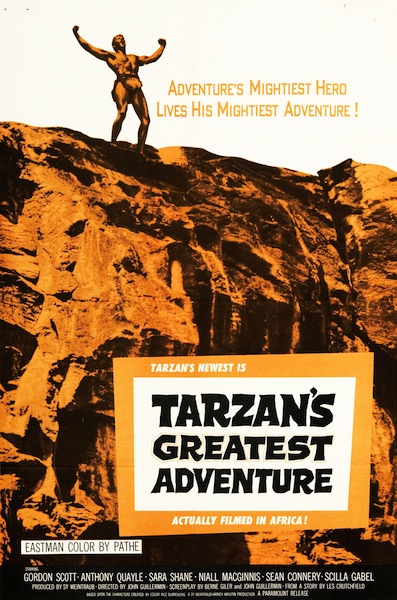 I’ve discovered a way to merge my recent posts about the manufacture-on-demand DVDs of The Bermuda Depths and The Last Dinosaur with my long-running Edgar Rice Burroughs posts. Tarzan’s Greatest Adventure, the 1959 live-action film now available from Warner Archive, also gives me a reason to go back to talking about Tarzan for the first time since I reviewed Tarzan and “The Foreign Legion”.
I’ve discovered a way to merge my recent posts about the manufacture-on-demand DVDs of The Bermuda Depths and The Last Dinosaur with my long-running Edgar Rice Burroughs posts. Tarzan’s Greatest Adventure, the 1959 live-action film now available from Warner Archive, also gives me a reason to go back to talking about Tarzan for the first time since I reviewed Tarzan and “The Foreign Legion”.
Johnny Weissmuller played Tarzan in twelve movies from 1932 to 1948. But Weissmuller’s departure from the role didn’t bring a halt to the series. It soldiered on, switching around studios and distributors (it had already flipped from MGM to RKO during Weissmuller’s tenure) for two more decades. Lex Barker, Gordon Scott, Jock Mahoney, and Mike Henry all played the Lord of the Jungle for at least two films each, and then the movies segued into the television series starring Ron Ely, who would later play another famous pulp hero in George Pal’s unfortunate Doc Savage: The Man of Bronze in 1975.
Tarzan’s Greatest Adventure arrived in the middle of this second stage of the jungle adventures and marked a major shift in style. Producer Sol Lesser left the series, and his replacement Sy Weintraub decided to revamp Tarzan with a “New Look.” Actually, it was more of an “Old Look”: Weintraub took Tarzan back to his literary roots and made a movie more faithful to Edgar Rice Burroughs’s book series. Tarzan suddenly gained a full mastery of the English language, and the story acquired a more adult tone.
Because of Weissmuller’s continued domination of the Tarzan-on-film image to this day — even the mighty Disney machine cannot overcome him — it’s hard to imagine the latter-day movies in the series as being any good. But Tarzan’s Greatest Adventure is excellent; it’s the ERB-fan’s Tarzan film. Not that I don’t love Weissmuller’s first two movies, but this is actually something pretty damn special for any Burroughs bibliophile. Even if it isn’t based on a specific novel, Tarzan’s Greatest Adventure ranks with last year’s John Carter of Mars and The Land That Time Forgot as a movie that honestly captures the style and feel of ERB’s work. Had he been alive to see it, Burroughs would definitely have approved of the film. He might have objected to Tarzan’s non-monogamy, if it can really be called that, since Jane’s existence is questionable at this point in the movie series.
Also: a pre-007 Sean Connery as one of the villains. And it was actually shot in Africa!
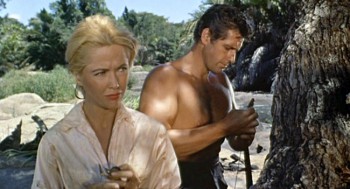 The story is a bare-bones chase plot similar to those ERB used in many of his novels: Tarzan is wronged; Tarzan pursuers wrongers; wrongers die viciously under the Ape Man’s feral wrath. The cuteness and comedy of earlier Tarzan movies is abandoned in the leaner approach, and Cheetah the Chimp makes only a token appearance at the beginning before Tarzan leaves him behind because there’s no room for comedy relief on this voyage. (Apparently, the trained chimps from the U.K. did not like the location shooting, but I can’t imagine a workable way to have Cheetah stick around no matter what.) The movie lacks the more outrageous elements of some of the original Tarzan books, such as lost civilizations and communicative apes, but in this stripped down form it comes close to the more down-to-earth installments of the series. The most noticeable change for casual viewers is Tarzan’s dialogue, which drops the “Me Tarzan” pidgin-speak for full English mastery.
The story is a bare-bones chase plot similar to those ERB used in many of his novels: Tarzan is wronged; Tarzan pursuers wrongers; wrongers die viciously under the Ape Man’s feral wrath. The cuteness and comedy of earlier Tarzan movies is abandoned in the leaner approach, and Cheetah the Chimp makes only a token appearance at the beginning before Tarzan leaves him behind because there’s no room for comedy relief on this voyage. (Apparently, the trained chimps from the U.K. did not like the location shooting, but I can’t imagine a workable way to have Cheetah stick around no matter what.) The movie lacks the more outrageous elements of some of the original Tarzan books, such as lost civilizations and communicative apes, but in this stripped down form it comes close to the more down-to-earth installments of the series. The most noticeable change for casual viewers is Tarzan’s dialogue, which drops the “Me Tarzan” pidgin-speak for full English mastery.
The Lord of the Jungle is up against a crew of diamond thieves led by Slade (Anthony Quayle), an old enemy. A few years past, Tarzan turned Slade over to the authorities after the man let his partners in an elephant hunt die just so the single-minded villain could bag the pachyderm himself. The animosity runs both ways, since Slade isn’t too forgiving toward the Ape Man for turning him in. Slade’s team attacks a native village in the opening scene to steal the dynamite they need for their diamond expedition, and during the attack they kill a local doctor. The doctor was a friend of Tarzan’s, which brings the Ape Man into the story and onto the trail upriver of Slade and Co. Tarzan picks up an unexpected partner along the way: pilot Angie (Sara Shane), who crashes her plane while buzzing over Tarzan’s canoe, apparently to check out his abs.
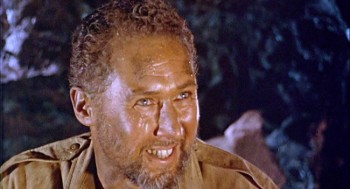 As Tarzan tightens the pursuit, Slade’s men start to bicker and fall apart. Slade’s attention begins to turn from the quest for the diamonds and toward the murder of Tarzan over all else, eventually heading into a delirious one-on-one climax after the cast has gotten thinned out by back-stabbing, wild animals, arrows, and quicksand. (The quicksand scene is surprisingly horrific.)
As Tarzan tightens the pursuit, Slade’s men start to bicker and fall apart. Slade’s attention begins to turn from the quest for the diamonds and toward the murder of Tarzan over all else, eventually heading into a delirious one-on-one climax after the cast has gotten thinned out by back-stabbing, wild animals, arrows, and quicksand. (The quicksand scene is surprisingly horrific.)
Gordon Scott was on his fourth portrayal of Tarzan since taking the role in 1955. In his first three movies (Tarzan’s Hidden Jungle, Tarzan and the Lost Safari, Tarzan’s Fight for Life) he played the character in the standard monosyllabic style Weissmuller made famous. For this film and its follow-up, Tarzan the Magnificent, Scott became a Tarzan capable of speaking sentences with verbs and definite and indefinite articles. After Jock Mahoney and then Mike Henry took over the part, this “New Look”/“New Sound” Tarzan continued.
Scott makes a fine Tarzan, although transparently not an actor by original calling — but neither was Johnny Weissmuller. Scott lacks Weissmuller’s charisma, but he handles the expanded dialogue with B-movie leading man quality, and he has a grip on Burroughs’s character when he delivers lines like this: “[The lion] killed for food. Only man kills for its own sake … Slade’s a man who has a — passion to kill … I would have killed Slade a long time ago if not for man’s law. Now he’s broken that law.” Scott’s Tarzan is a rough customer, efficient and dangerous, with no scruples about killing evil-doers. Even his tussle with a clearly rubber alligator has a great primal fury to it.
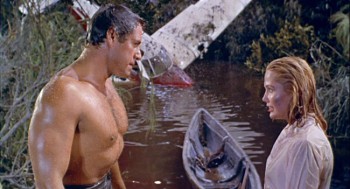 Scott works well across from perky Sara Shane’s Angie, whose hair always has the right flip to it after days and nights in the jungle. And yes, Tarzan and Angie do it. Not on screen, of course; this was still the 1950s. This raises a question for viewers unfamiliar with the larger Tarzan corpus: What about Jane? Burroughs’s heroes never break their monogamous relationships. The script makes no mention of Jane, and she seems not to exist at all. In fact, only one of Gordon Scott’s Tarzan movies has Jane appear. Burroughs also dropped mention of Jane from many of the latter batch of his Tarzan novels, although he never gave Tarzan new lovers. Since I’ve always found Burroughs’s rigidity about his heroes’ fidelity dramatically limiting, this is a change to the Tarzan mythos that doesn’t bother me.
Scott works well across from perky Sara Shane’s Angie, whose hair always has the right flip to it after days and nights in the jungle. And yes, Tarzan and Angie do it. Not on screen, of course; this was still the 1950s. This raises a question for viewers unfamiliar with the larger Tarzan corpus: What about Jane? Burroughs’s heroes never break their monogamous relationships. The script makes no mention of Jane, and she seems not to exist at all. In fact, only one of Gordon Scott’s Tarzan movies has Jane appear. Burroughs also dropped mention of Jane from many of the latter batch of his Tarzan novels, although he never gave Tarzan new lovers. Since I’ve always found Burroughs’s rigidity about his heroes’ fidelity dramatically limiting, this is a change to the Tarzan mythos that doesn’t bother me.
The cast of villains is the hefty goods here. And it’s a hefty bunch: Anthony Quayle (Lawrence of Arabia), Niall McGinnis (the evil magician of The Night of the Demon; Zeus in Jason and the Argonauts), Al Mulock (who appeared — and got shot — in the opening scenes of both The Good, the Bad and the Ugly and Once Upon a Time in the West), and that Sean Connery fellow.
From the perspective of this film and 1959, casting Sean Connery to play a sophisticated British secret agent with a refined taste in Martinis seems like an absurd move. Seriously? You want this man, this grinning roughneck lout, to play James Bond? If I were an Ian Fleming reader back in 1962, I’d wonder if the Dr. No producers had cracked their heads on the bathtub edge when they said, “Yeah, let’s go with this guy.” It’s a testament to Connery’s acting chops that he turned out to be perfect for James Bond, managing to play suave and have the same dangerous edge that he shows here. It’s also praise that I found myself, from the perspective of 2013 and hardcore 007 fandom, rapidly forgetting about Connery’s most famous role and settling in to his performance as a character with a nasty sort of charm and not a hint of class. O’Bannion is an Irish mercenary who would have found a just cause to fight for, except “just causes don’t pay too good.”
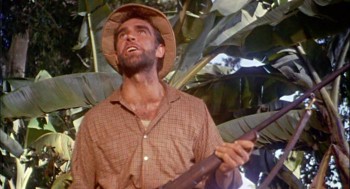 Even among such company as McGinnis and Connery, Anthony Quayle shines as Slade, the prime villain. At first, Slade looks like a standard one-dimensional baddie. But as the men in his company begin to crack apart, the layers start to rub off Slade. Quayle is very effective across from the scheming McGinnis, who plays the ex-Nazi diamond expert Kruger, and Scialla Gabel, who plays Slade’s mistress and the only person on the boat who has a conscience. She sees Slade eroding toward tragedy and tries to intervene, but of course the man is going to stay the course until it comes down to him and Tarzan. Quayle gives a fantastic slow burn performance of the best type, steaming toward hysteria for the climax.
Even among such company as McGinnis and Connery, Anthony Quayle shines as Slade, the prime villain. At first, Slade looks like a standard one-dimensional baddie. But as the men in his company begin to crack apart, the layers start to rub off Slade. Quayle is very effective across from the scheming McGinnis, who plays the ex-Nazi diamond expert Kruger, and Scialla Gabel, who plays Slade’s mistress and the only person on the boat who has a conscience. She sees Slade eroding toward tragedy and tries to intervene, but of course the man is going to stay the course until it comes down to him and Tarzan. Quayle gives a fantastic slow burn performance of the best type, steaming toward hysteria for the climax.
And the climax is a corker. When Tarzan and Slade at last tussle on a crumbling cliff side, Slade trying to use a metal noose to garrote his opponent, the fight gets downright nasty. No clean fisticuffs or acrobatic choreography on display here; this fight is gouging and scratching and feverish desperation, a perfect fulfillment of the promise of Slade’s character development. Tarzan’s final victory yell is damn well earned.
As advertised on its poster, Tarzan’s Greatest Adventure was indeed shot on location in Africa. It makes a huge difference to see the actors, not simply stand-ins, walking among the Kenyan locations, sweating and toiling. The danger is tangible, and Tarzan’s natural connection to the jungle wilds is much more impressive when viewers can see his ease with an actual jungle. The location is especially vivid in the finale among jutting rocks over a river, a setting that looks more fantastic than anything that might be mocked-up in a studio. Stock shots still show up for most of the wild animal footage, however. Can’t have everything.
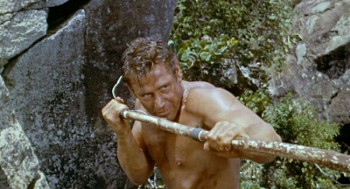 Director John Guillermin had a prolific career in movies, directing his first film in 1949 and retiring in 1988. He often worked as a journeyman for big name producers, such as Irwin Allen on The Towering Inferno and Dino de Laurentiis on the 1976 King Kong re-make. Guillermin was not a visionary, but Tarzan’s Greatest Adventure doesn’t require one; he handles the action and drama with a crisp and sure style. Along with the World War I drama The Blue Max (1966), Towering Inferno, and the charming Hercule Poirot mystery Death on the Nile (1978), this is Guillmerin’s best work. He did one more Tarzan film, the first of Jock Mahoney’s two outings, Tarzan in India (1962). And yes, it was filmed in India.
Director John Guillermin had a prolific career in movies, directing his first film in 1949 and retiring in 1988. He often worked as a journeyman for big name producers, such as Irwin Allen on The Towering Inferno and Dino de Laurentiis on the 1976 King Kong re-make. Guillermin was not a visionary, but Tarzan’s Greatest Adventure doesn’t require one; he handles the action and drama with a crisp and sure style. Along with the World War I drama The Blue Max (1966), Towering Inferno, and the charming Hercule Poirot mystery Death on the Nile (1978), this is Guillmerin’s best work. He did one more Tarzan film, the first of Jock Mahoney’s two outings, Tarzan in India (1962). And yes, it was filmed in India.
The usual caveats for a manufacture-on-demand DVD apply: no restoration, no remastering, no extras, generic main menu, chapter stops every ten minutes. The theatrical presentation aspect ratio of 1.85:1 is preserved, enhanced for 16×9 televisions, with the original mono mix. The picture quality is average; it’s about what I would expect if I saw the movie at a budget theater during its original run, with a print that’s seen some wear but remains watchable without serious distractions.
Warner Archive has released other of the later Tarzan films on MOD DVD. Now I want to check out the Mike Henry 1966 film Tarzan and the Valley of Gold, which has the distinction of getting a novelization by none other than Fritz Leiber.
Ryan Harvey is one of the original bloggers for Black Gate, starting in 2008. He received the Writers of the Future Award for his short story “An Acolyte of Black Spires,” and his stories “The Sorrowless Thief” and “Stand at Dubun-Geb” are available in Black Gate online fiction. A further Ahn-Tarqa adventure, “Farewell to Tyrn”, is currently available as an e-book. Ryan lives in Los Angeles. Occasionally, people ask him to talk about Edgar Rice Burroughs or Godzilla in interviews.
“Les Baxter, Gordon Scott, Jock Mahoney, and Mike Henry all played the Lord of the Jungle for at least two films each”
Say what?
Oh, if only Les Baxter, Lord of Exotica & the Lounge, had played the Ape Man, what a better world this would be.
That’s Lex Barker, but the source of confusion is both understandable and delightful.
And Tarzan’s Greatest Adventure is fully as fine as you say.
Very fine write up of one of the best of the Tarzan films. I picked up this DVD on demand a couple of years ago. Gordon Scott was excellent as the ape man. He came to a peculiar end. After Tarzan he did some Italian sand and sandal films and sort of disappeared. He ended up in old age living not far from here near Baltimore, Md. living in the basement of the home of a fan, who had invited him to come for a visit. Scott came off the plane in a wheel chair and never left. His devoted fan took care of him for several years until he died. Strange finish for the Lord of the Jungle.
Sorry Chris, I meant Les Brown. I apologize for confusing my musicians. 🙂
[…] Speaking of Tarzan movies, did you know that a new live-action film is gearing up? Perhaps not, since it has been “bubbling under” in entertainment news and only in the last few months started to reach a boil people might notice, but yeah — it’s a thing. Thinking over the progress toward another adventure of the Lord of the Jungle — who is 101 years old this October — helps me cope with another anniversary, this one only a year old. It’s a bittersweet memory, but let me go over it a moment before returning to Tarzan. […]
[…] in North America on bootlegs swiped off Japanese laserdiscs. (Yeah, you own a couple of those.) Tarzan’s Greatest Adventure, The Bermuda Depths, and The Last Dinosaur all come from Warner Brothers’ MOD division. But two […]
[…] shows with this opening that he has taken the “New Look” Tarzan he introduced in 1959 in Tarzan’s Greatest Adventure one step further to imitate the stratospheric popularity of spy cinema of the decade. Tarzan not […]
[…] the two seasons of the Ron Ely television story. The best of the lot for a more casual viewer is Tarzan’s Greatest Adventure (1959), but Tarzan the Magnificent from 1960 comes a close second to it. It’s not as lean and […]
[…] It gets nowhere near the quality of the earlier “New Look” Tarzan films with Gordon Scott — Tarzan’s Greatest Adventure and Tarzan the Magnificent — yet it manages to move the Ape Man, played by Mike Henry, smoothly […]
[…] in North America on bootlegs swiped off Japanese laserdiscs. (Yeah, you own a couple of those.) Tarzan’s Greatest Adventure, The Bermuda Depths, and The Last Dinosaur all come from Warner Brothers’ MOD division. But two […]